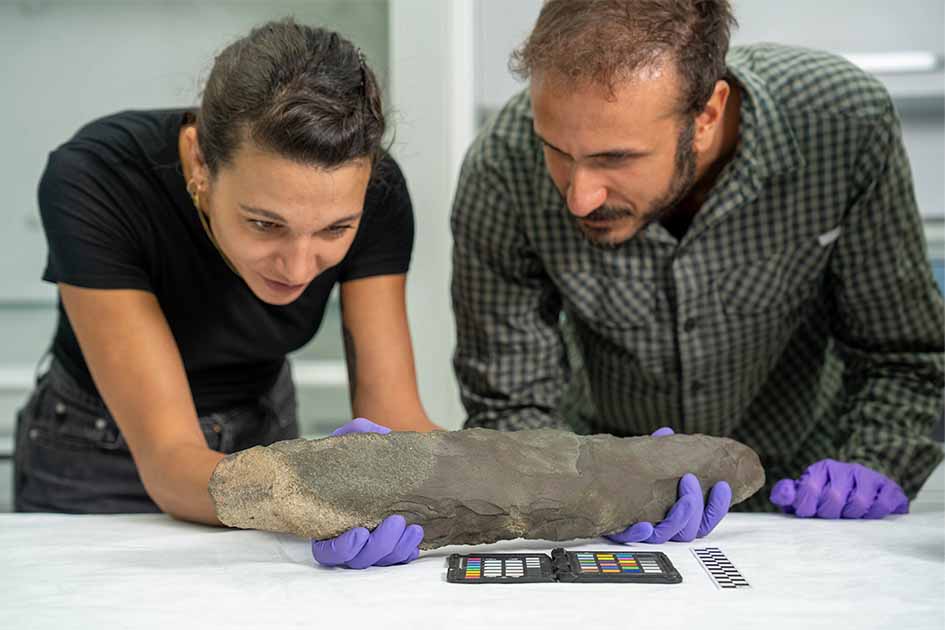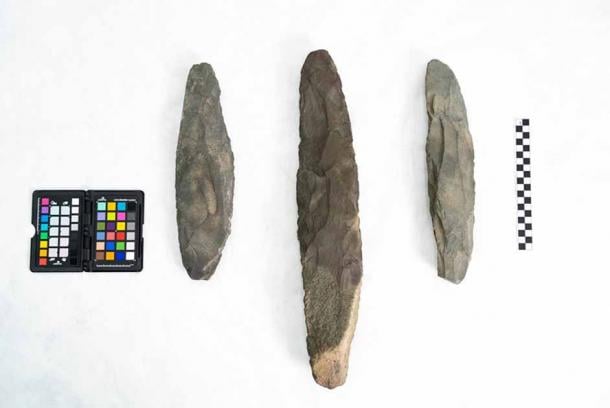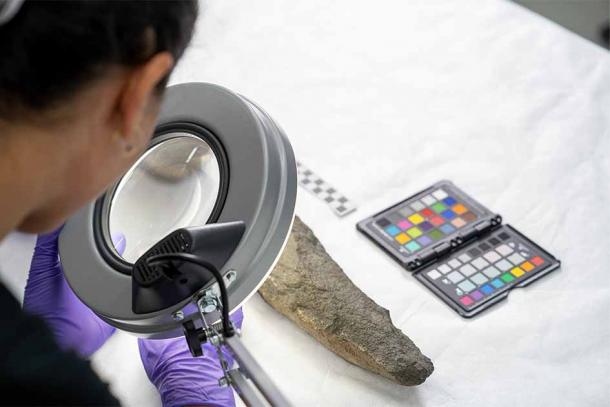Archaeologists digging at the Qurh site in Saudi Arabia’s AlUla Governorate uncovered a set of enormous stone hand axes that were made by ancient humans living in the region 200,000 years ago, reported the Saudi Press Agency. These remarkable relics are an exceptionally rare find, and their recovery will provide valuable new information about the toolmaking practices and capabilities of people who occupied the Arabian Peninsula during the Lower Middle Paleolithic Age.


Three prehistoric hand axes unearthed at Qurh Plain AlUla in Saudi Arabia. (The Royal Commission for AlUla (RCU))
The Impressive Craftsmanship Displayed by Prehistoric Hand Axes
The astonishingly ancient tools were unearthed by archaeologists from TEOS Heritage, a consultancy firm hired by Saudi Arabia’s Royal Commission for AlUla to explore the huge Qurh archaeological site in west-central Saudi Arabia.
Although these objects were created in prehistoric times, the makers of the stone hand axes displayed impressive craftsmanship in creating them. The most notable among the tools uncovered in Saudi Arabia is a 20-inch (51-centimeter) long axe crafted from soft basalt stone, mirroring the material of the other axes. This formidable tool possessed the strength and sharpness necessary for cutting and chopping various organic materials, including plants, pieces of wood, animal hides and flesh.
“This hand axe is one of the most important finds from our ongoing survey of the Qurh Plain,” said TEOS Heritage Project Director Dr Ömer Aksoy in a Royal Commission for AlUla news release. “This amazing stone tool is more than a half a meter long and is the largest example of a series of stone tools discovered on the site. An ongoing search for comparisons from across the world has not come up with a hand axe of equal size. As such this may well be one of the largest hand axes ever discovered.”
Despite its impressive size, this tool could have been held and swung with one hand. The basalt rock employed in its creation is both comparatively lightweight and robust, rendering it the ideal choice for crafting tools of this nature.

One of the prehistoric hand axes in situ. (The Royal Commission for AlUla (RCU))
Prehistoric Hand Axes Prove Presence of Toolmaking Homo Sapiens
Qurh (Al-Mabiyat) is located near the village of Mugheira, 12 miles (20 kilometers) from the modern city of AlUla. In the center of the site is a sprawling excavated area known as Deira (The Town), which includes many ancient buildings, mosques, sections of a city wall and a marketplace courtyard that all date back to the seventh and eighth centuries AD.
This settlement was at its most prosperous during this early Islamic period, and in fact most of the artifacts recovered during the ongoing excavations have been linked to that time. But, despite the preponderance of early Islamic artifacts, archaeologists have never doubted that the site was inhabited by earlier cultures, and they have remained hopeful of eventually discovering artifacts that would reveal the site’s true timeline of occupation.
Needless to say, the TEOS archaeological team were delighted to recover items that were made so long ago. The carefully carved prehistoric axes found in Saudi Arabia, of which more than a dozen were unearthed in total, are a singular and extraordinary find. Their existence at the site has proved that the area was occupied by toolmaking Homo sapiens ancestors who lived long before the modern age.
At present, the archaeologists are going over the stone hand axes with a fine-tooth comb. They’re trying to figure out exactly how the axes were used and what they were used for, which may be possible from an examination of use marks found on the surfaces of these Paleolithic period artifacts.

The prehistoric hand axes are now undergoing thorough investigation. (The Royal Commission for AlUla (RCU))
Who Were the Paleolithic Stone Toolmakers of Ancient Arabia?
It is well known that the largest migrations of ancient humans out of Africa occurred within the last 100,000 years. But the people responsible for the manufacture of the stone hand axes moved into the Arabian Peninsula at an earlier time, when the climate was greener and wetter, and survival in the region was much easier.
While the greatest numbers of Homo sapiens moved into the lands of modern-day Saudi Arabia within the past 80,000 years, they were not the original migrants. The latest research suggests humans left Africa in five different waves starting 400,000 years ago, which means the stone toolmaking culture might have established a presence on the Arabian Peninsula tens of thousands of years—or even longer—before the stone axes were actually manufactured.
Archaeologists are unable to say much about these ancient toolmakers, beyond acknowledging their ability to make cutting and chopping axes that were ideally suited for people pursuing a hunting and gathering lifestyle.
Nevertheless, the excavations around Qurh are slated to continue for a quite some time, as archaeologists have currently opened up 11 different areas for exploration. This means that it is possible—if not likely—that other extremely ancient artifacts will be found at some point, which would help experts learn more about how the Arabian Peninsula’s oldest human settlers lived and survived.





